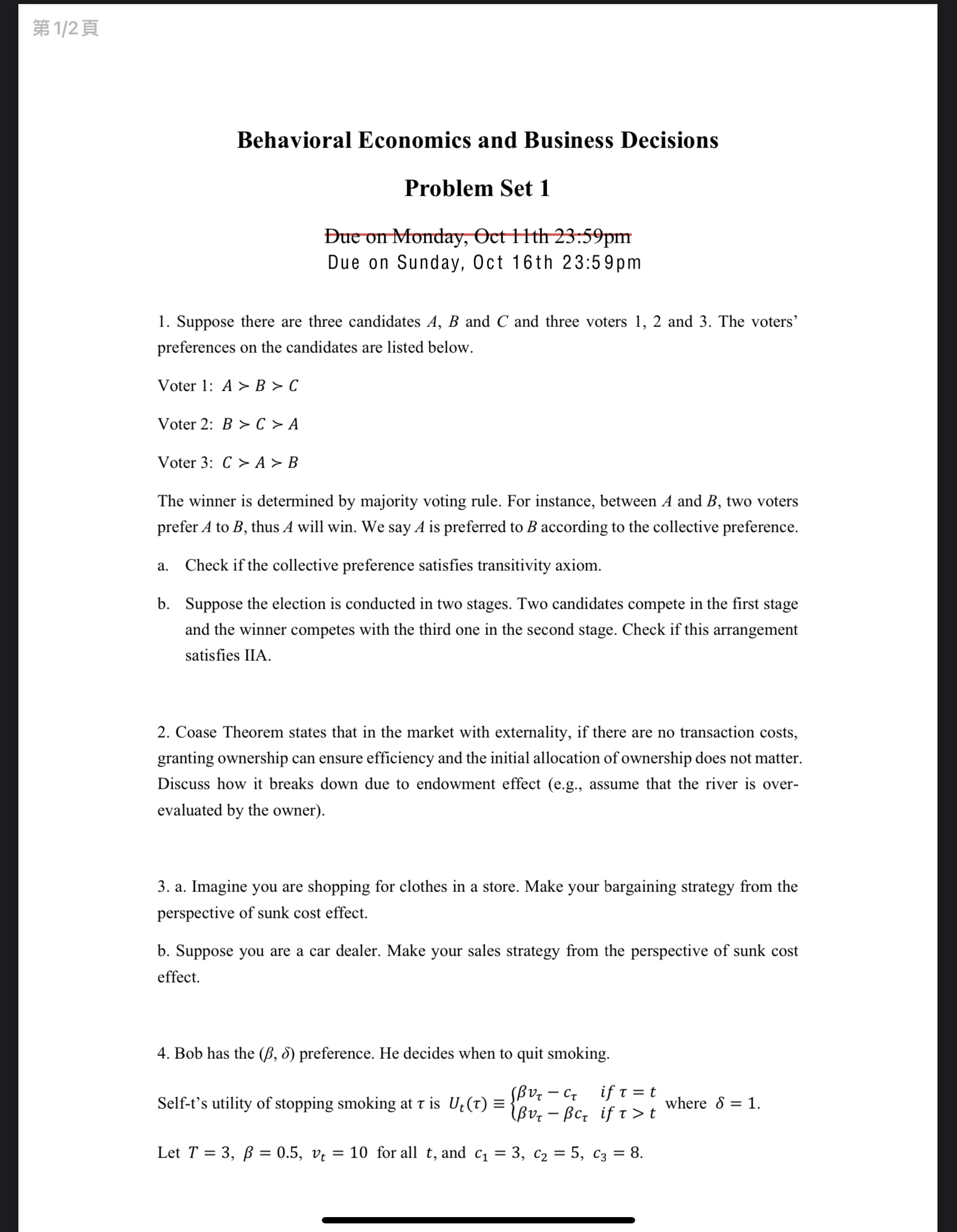

Behavioral Economics and Business Decisions Problem Set 1 ue on Monday, Oct 11th 23:59pm Due on Sunday, Oct 16 th 23:59pm 1. Suppose there are three candidates A,B and C and three voters 1,2 and 3 . The voters' preferences on the candidates are listed below. Voter 1: A>B>C Voter 2:B>C>A Voter 3: C>A>B The winner is determined by majority voting rule. For instance, between A and B, two voters prefer A to B, thus A will win. We say A is preferred to B according to the collective preference. a. Check if the collective preference satisfies transitivity axiom. b. Suppose the election is conducted in two stages. Two candidates compete in the first stage and the winner competes with the third one in the second stage. Check if this arrangement satisfies IIA. 2. Coase Theorem states that in the market with externality, if there are no transaction costs, granting ownership can ensure efficiency and the initial allocation of ownership does not matter. Discuss how it breaks down due to endowment effect (e.g., assume that the river is overevaluated by the owner). 3. a. Imagine you are shopping for clothes in a store. Make your bargaining strategy from the perspective of sunk cost effect. b. Suppose you are a car dealer. Make your sales strategy from the perspective of sunk cost effect. 4. Bob has the (,) preference. He decides when to quit smoking. Self-t's utility of stopping smoking at is Ut(){vcvcif=tif>t where =1. Let T=3,=0.5,vt=10 for all t, and c1=3,c2=5,c3=8. a. Suppose Bob is naive. When will Bob stop smoking? Provide a proof for your answer. b. Suppose Bob is sophisticated. When will Bob stop smoking? Provide a proof for your answer. c. Suppose at t=1, the partially naive Bob believes that ^=0.7. When will Bob stop smoking? Provide a proof for your answer. 5. In the lab experiment, a subject's response in a time preference elicitation task is as below. Calculate the corresponding and values for a period of 30 days. Behavioral Economics and Business Decisions Problem Set 1 ue on Monday, Oct 11th 23:59pm Due on Sunday, Oct 16 th 23:59pm 1. Suppose there are three candidates A,B and C and three voters 1,2 and 3 . The voters' preferences on the candidates are listed below. Voter 1: A>B>C Voter 2:B>C>A Voter 3: C>A>B The winner is determined by majority voting rule. For instance, between A and B, two voters prefer A to B, thus A will win. We say A is preferred to B according to the collective preference. a. Check if the collective preference satisfies transitivity axiom. b. Suppose the election is conducted in two stages. Two candidates compete in the first stage and the winner competes with the third one in the second stage. Check if this arrangement satisfies IIA. 2. Coase Theorem states that in the market with externality, if there are no transaction costs, granting ownership can ensure efficiency and the initial allocation of ownership does not matter. Discuss how it breaks down due to endowment effect (e.g., assume that the river is overevaluated by the owner). 3. a. Imagine you are shopping for clothes in a store. Make your bargaining strategy from the perspective of sunk cost effect. b. Suppose you are a car dealer. Make your sales strategy from the perspective of sunk cost effect. 4. Bob has the (,) preference. He decides when to quit smoking. Self-t's utility of stopping smoking at is Ut(){vcvcif=tif>t where =1. Let T=3,=0.5,vt=10 for all t, and c1=3,c2=5,c3=8. a. Suppose Bob is naive. When will Bob stop smoking? Provide a proof for your answer. b. Suppose Bob is sophisticated. When will Bob stop smoking? Provide a proof for your answer. c. Suppose at t=1, the partially naive Bob believes that ^=0.7. When will Bob stop smoking? Provide a proof for your answer. 5. In the lab experiment, a subject's response in a time preference elicitation task is as below. Calculate the corresponding and values for a period of 30 days








